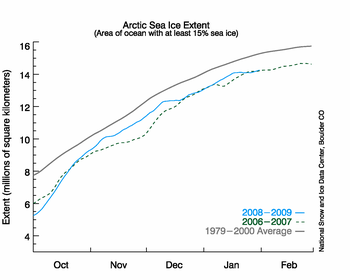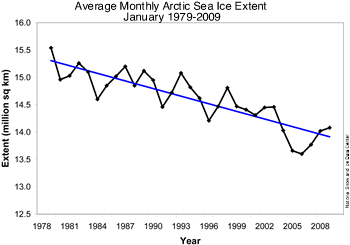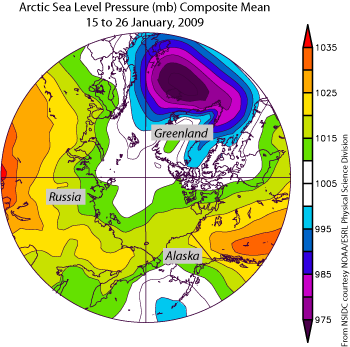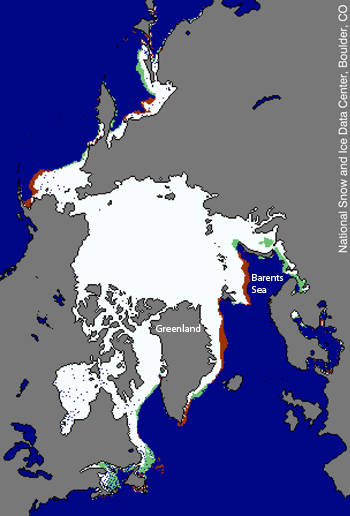As is typical during mid-winter, sea ice extent increased overall in January; maximum monthly extent is expected in March. However, January ice extent remained well below normal compared to the long-term record. Ice extent averaged for January 2009 is the sixth lowest January in the satellite record. Also of note is that from January 15 to 26, ice extent saw essentially no increase; an unusual wind pattern appears to have been the cause.

Figure 1. Arctic sea ice extent for January 2009 was 14.08 million square kilometers (5.43 million square miles). The magenta line shows the 1979 to 2000 median extent for January. The black cross indicates the geographic North Pole. Sea Ice Index data. About the data.—Credit: National Snow and Ice Data Center
High-resolution image
Overview of conditions
Arctic ice extent averaged for the month of January was 14.08 million square kilometers (5.43 million square miles). January extent was 760,000 square kilometers (293,000 square miles) less than for the 1979 to 2000 average, and 310,000 square kilometers (120,000 square miles) greater than for January 2007.
During the month of January, Arctic sea ice extent increased by 1.12 million square kilometers (440,000 square miles), an average increase of 36,000 square kilometers (13,900 square miles) per day.
 Figure 2. The graph above shows daily sea ice extent.The solid blue line indicates 2008–2009; the dashed green line shows 2006–2007 (the record-low summer minimum occurred in 2007); and the solid gray line indicates average extent from 1979 to 2000. Sea Ice Index data.
Figure 2. The graph above shows daily sea ice extent.The solid blue line indicates 2008–2009; the dashed green line shows 2006–2007 (the record-low summer minimum occurred in 2007); and the solid gray line indicates average extent from 1979 to 2000. Sea Ice Index data.—Credit: National Snow and Ice Data Center
High-resolution image
Conditions in context
While ice extent climbed through the month of January as a whole, the period from January 15 to 26 saw almost no increase in ice extent, appearing as a flattening in the line graph. Extent during this pause remained fairly steady at around 14.0 million square kilometers (5.4million square miles).
 Figure 3. Monthly January ice extent for 1979 to 2009 shows 2009 as the sixth lowest January on record.
Figure 3. Monthly January ice extent for 1979 to 2009 shows 2009 as the sixth lowest January on record.
—Credit: National Snow and Ice Data Center
High-resolution image
January 2009 average extent compared to past Januaries
Average ice extent for January 2009 was the sixth lowest in the satellite record. January 2006 had the lowest ice extent for the month; January 2005 claims second place; and January 2007 is in third place. Including 2009, the downward linear trend in January ice extent stands at -3.1% per decade.
Figure 4. This map compares ice extent on January 15 to ice extent on January 26, 2009. Areas in red indicate where ice was present on January 15 but had disappeared by January 26; areas in green indicate where ice was not present on January 15 but had appeared by January 26. Note in particular the regional balance between reduced ice extent in parts of the Arctic and increased extent in others. Sea Ice Index data.
—Credit: National Snow and Ice Data Center
High-resolution image
A balancing act of regional growth and decline
The pause in total sea ice extent change from January 15 to 26 reflects expanding and declining ice extent in different areas of the Arctic. For example, ice extent increased southwest of Greenland but decreased in areas east of Greenland and in parts of the Barents Sea.
This regional variability of sea ice extent as seen from satellites gives the bird’s-eye view of the changeable conditions on the ground that Arctic residents must deal with. One Arctic community may note increased sea ice extent, while at the same time another community not far away may note decreased sea ice extent.
 Figure 5. The map of sea level pressure (in millibars) averaged over the Arctic for the period January 15 to 26, 2009, reveals one of the reasons for the pause in ice extent change—the strong low-pressure feature (blue and purple) centered just south of Iceland.
Figure 5. The map of sea level pressure (in millibars) averaged over the Arctic for the period January 15 to 26, 2009, reveals one of the reasons for the pause in ice extent change—the strong low-pressure feature (blue and purple) centered just south of Iceland.—Credit: From National Snow and Ice Data Center courtesy NOAA/ESRL Physical Sciences Laboratory
High-resolution image
The reason for the pause in January average ice extent change
The pause in ice extent change from January 15 to 26 is somewhat similar to an event that characterized part of December 2008. Both times, the cause for the pause was an unusual pattern of atmospheric circulation.
January 15 to 26 saw very strong low pressure centered just south of Iceland—a very strong Icelandic Low . In accord with Buys Ballot’s Law, strong warm winds from the south and southeast encouraged ice decline in areas east of Greenland and in parts of the Barents sea area. The winds helped compact the ice cover and reduce ice growth. Regional winds from the north explain the increases in ice extent southwest of Greenland.
This strong Icelandic Low was present at the same time that atmospheric pressures were especially high over the subtropical North Atlantic. This large-scale pattern of atmospheric pressure and the regional pattern of changes in ice extent on the Atlantic side of the Arctic are classic signals of the positive phase of the North Atlantic Oscillation (NAO). The negative phase would have a weaker Icelandic Low, and roughly the inverse pattern of sea ice extent anomalies (the red and green in Figure 4 would be approximately reversed). The NAO has climate impacts not just in the Arctic, but in North America and Europe as well.
References
Rigor, I. G., J. M. Wallace, and R. L. Colony. 2002. Response of Sea Ice to the Arctic Oscillation. AMS Journal of Climate Volume 15 Issue 18; 2648–2663.
For previous analysis, please see the drop-down menu under Archives in the right navigation at the top of this page.


